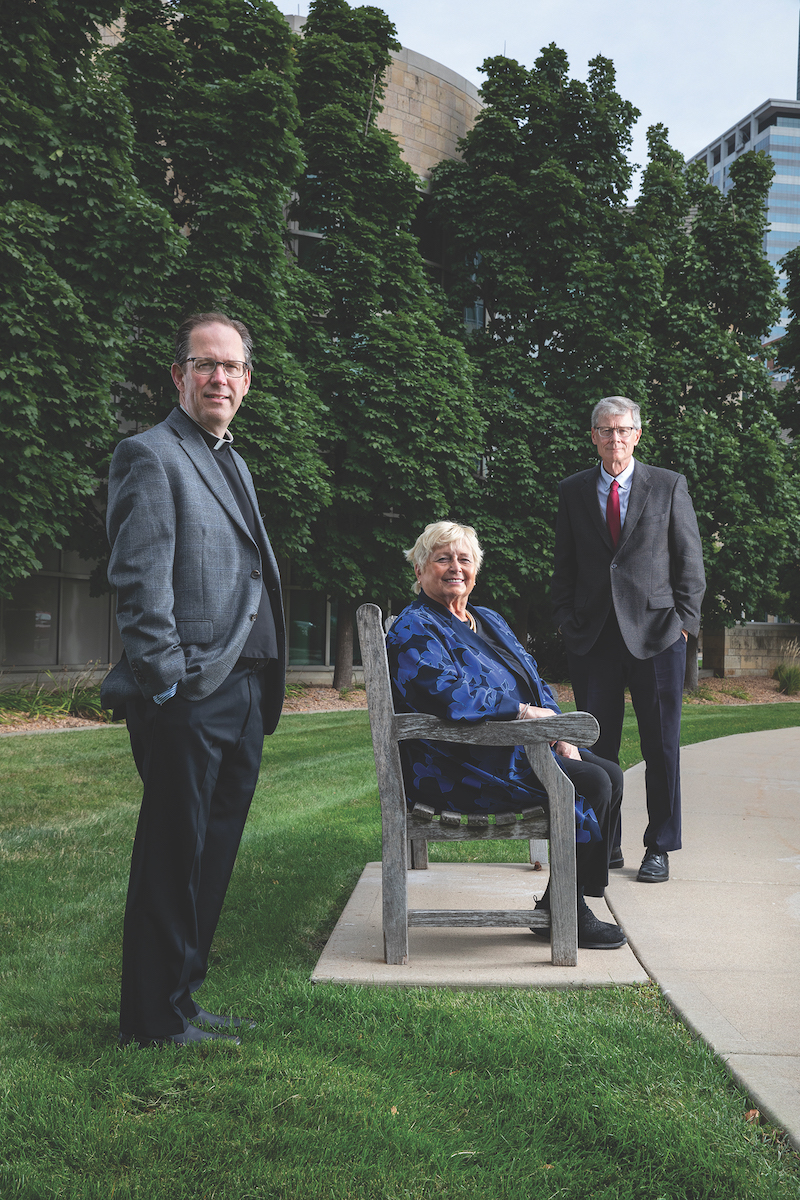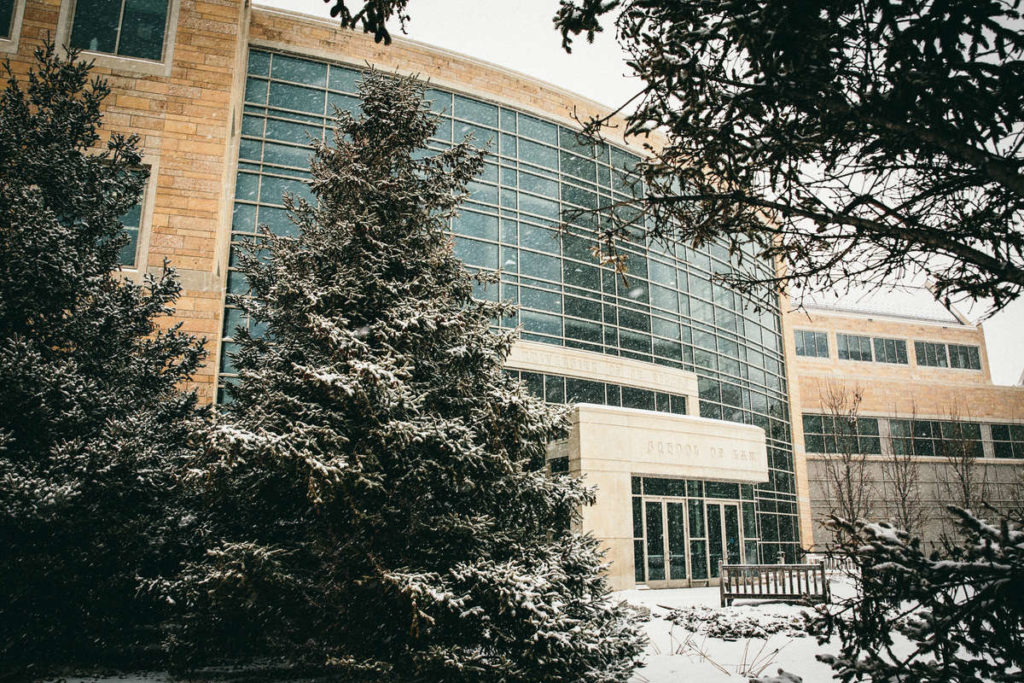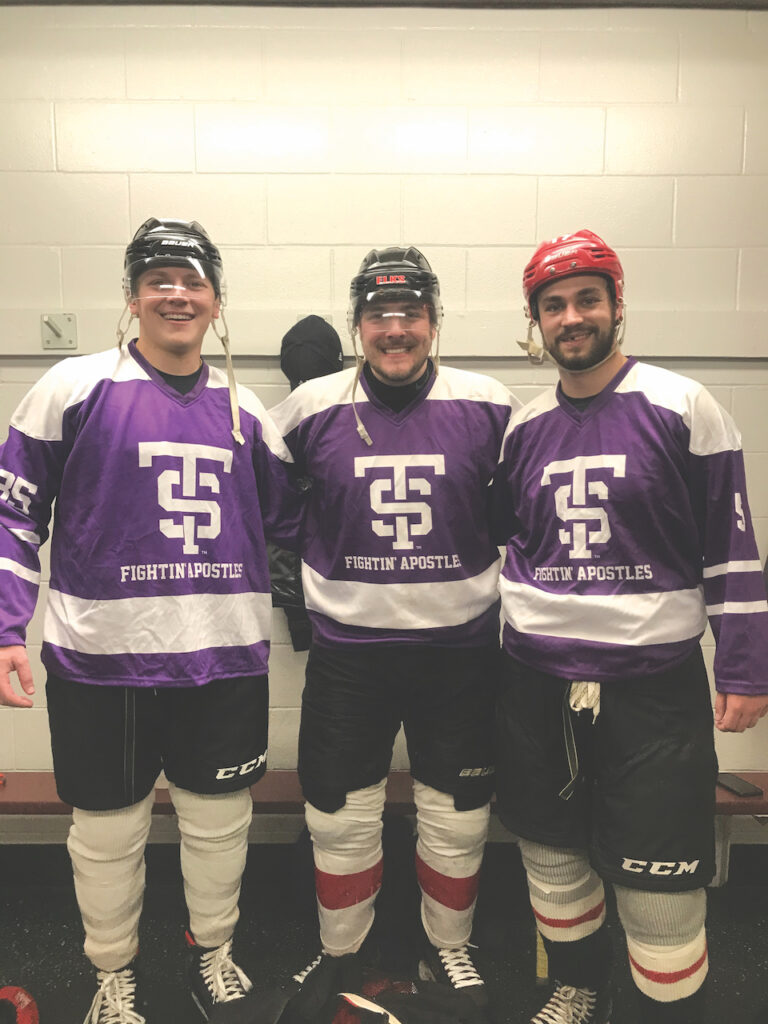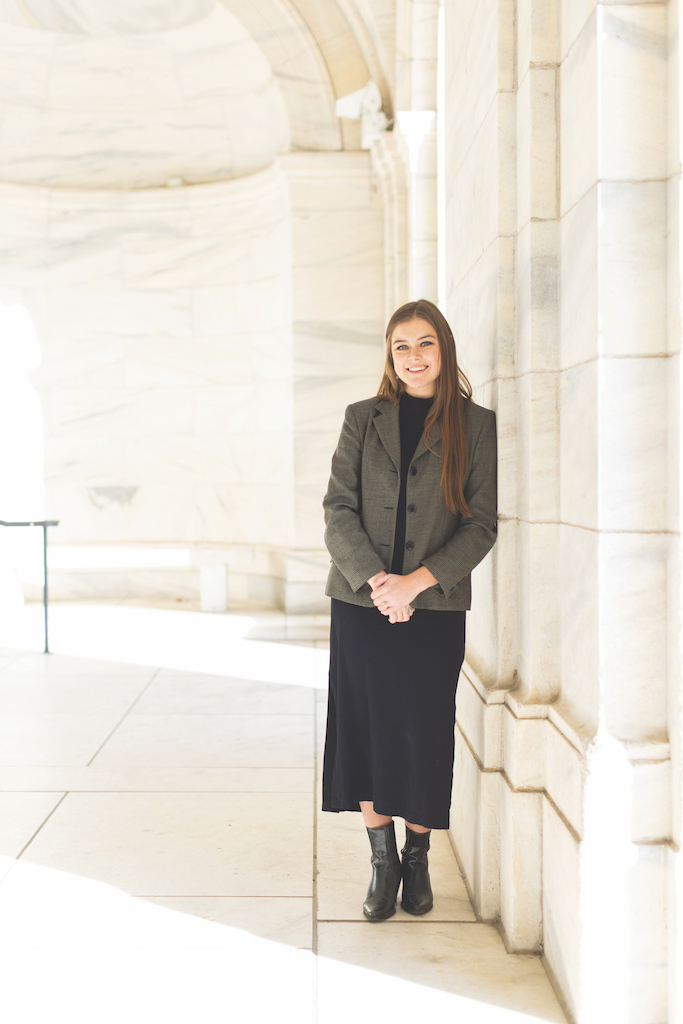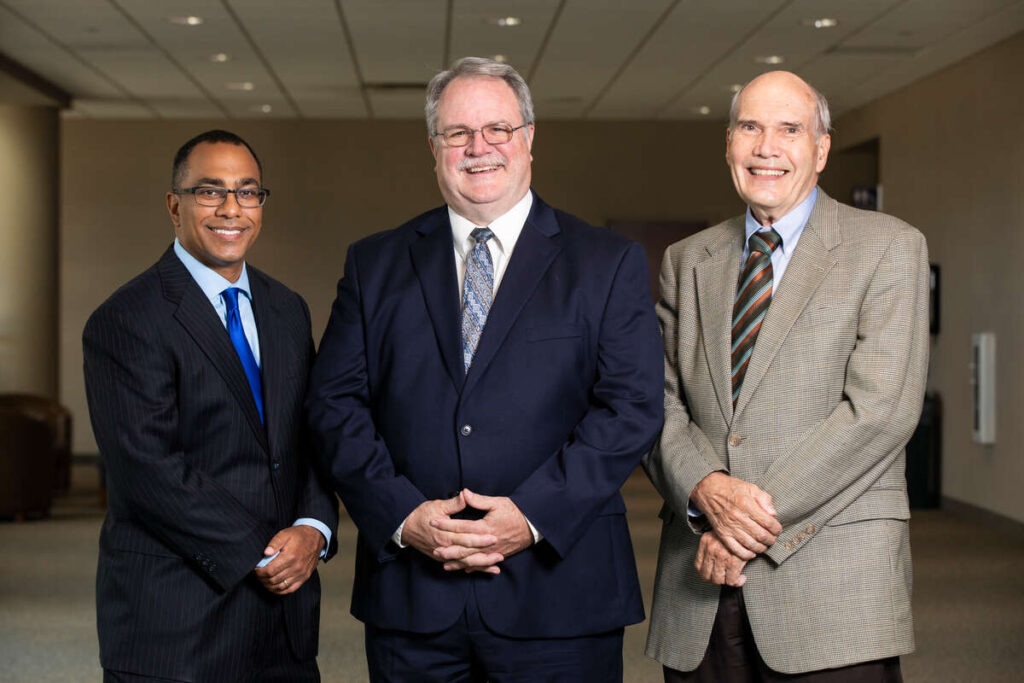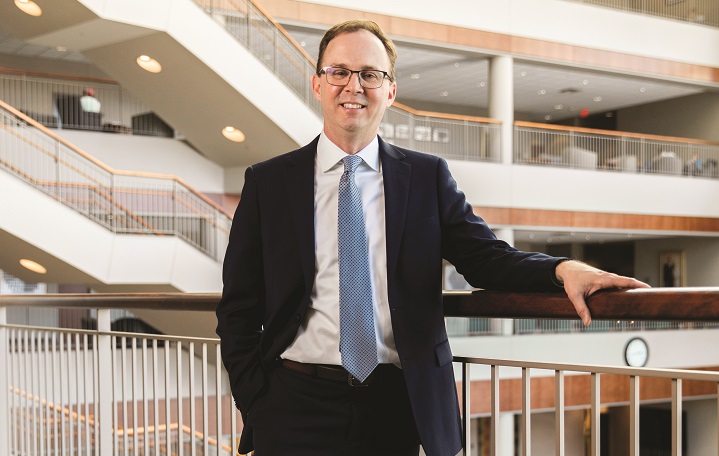This story is featured in the winter 2020 issue of St. Thomas Lawyer.
Restorative justice, an alternative approach to dealing with harm, is taking hold at the School of Law in the form of a new class.
The course, titled Restorative Justice, Law and Healing, is taught by Wenger Family Fellow of Law Father Daniel Griffith and School of Law Senior Distinguished Fellow and Fellow of the Holloran Center Hank Shea.
Restorative justice was the topic of the St. Thomas Law Journal’s fall 2019 symposium, which Shea and Griffith helped organize. Shea helped attendees understand restorative justice in his opening talk at the event.
“Put aside most people’s traditional notions of punishment, which is generally about retribution – giving the wrongdoer what he or she deserves. Put that aside and open up your minds and your hearts to a different way of looking at how we should deal with wrongdoing in our society,” Shea said at the symposium. “How do we do something for the victim-survivor, for the wrongdoer, for the community – which are all impacted by so many criminal actions? And what we do is we find out what they really need, what can help them heal – and that’s the way you can achieve justice in a restorative manner.”
That event featured a who’s who of restorative justice leaders in the Midwest. In addition to Shea, the symposium also featured Griffith, former Wisconsin Supreme Court Judge Janine Geske and Director of the Center on Race, Leadership and Social Justice at the School of Law Artika Tyner ’06 J.D., ’10 MA, ’12 EdD.
A Restorative Justice Primer
In explaining restorative justice at the symposium, Geske said, “[Restorative justice] is really a philosophical approach to dealing with harm. It’s that broad. People can be harmed by something that isn’t criminal. The only thing that makes a crime is that the legislature has decided to make it a crime.”
Geske described the restorative justice framework as a triangle. At the top of the triangle are victim-survivors; the focus on the victim is what makes restorative justice different from the U.S. criminal justice system. The second point of the triangle is community – people and institutions who are harmed but may not specifically know the victim. The perpetrator, who put into motion the harm, is the third point in the triangle.
She explained that there are three questions in restorative justice: Who was harmed? What was the harm? How do we go about repairing the harm?
In sharing with symposium attendees her take on restorative justice, Tyner mentioned Micah 6:8, “He has shown you, O mortal, what is good. And what does the Lord require of you? To act justly and to love mercy and to walk humbly with your God.”
“We have a responsibility as lawyers and as a community to help and repair the world,” Tyner said. She added that restorative justice is an alternative that works.

Restorative justice provides many benefits, the foremost of which is healing. Shea, a former assistant U.S. attorney, said that the criminal justice process is very formulaic and doesn’t give a person the opportunity to ask the offender, “Why me?” Restorative justice requires the offender to look the victim-survivor in the eye and explain why.
“When people are given an opportunity to talk about how they experienced harm, it is in fact a healing experience for them,” Griffith said.
Another benefit is that restorative justice can be a bridge to both direct and peripheral harm. Griffith also said that it can be a way for perpetrators to experience restoration and understand the impact of their behavior, which fosters greater accountability.
Regarding a third benefit, Griffith said, “We live in a world where increasingly we are not in dialogue. We’re walled off from each other. Restorative justice is really in accord with the nature of the human person. We’re meant to be social – that’s how we’re created.” He added that we need more respectful dialogue in society.
‘A Call Within a Call’
Griffith also is the pastor of Our Lady of Lourdes Catholic Church in Minneapolis and is the liaison for restorative justice and healing for the Archdiocese of Saint Paul and Minneapolis. In talking about restorative justice, like Tyner he referenced the Bible, noting that the word “restore” is in Scripture 130 times.
He came to restorative justice in numerous ways. Shea set up a dinner with Griffith and Geske a few years ago, where Griffith heard many stories about how she came to restorative justice. In addition, Our Lady of Lourdes accepted an invitation from the archdiocese to pilot a parish program in restorative justice. Griffith also had served as a delegate for a safe environment for the archdiocese, dealing with clergy abuse.
“I felt a call within a call,” Griffith said. “I’m called to priesthood, and then within priesthood I felt a particular call to get into this ministry. It’s happened organically, and every step along the way I have felt an affirmation to continue to do the work and to get into it more in depth.”
Shea’s most popular course at the School of Law is Crime and Punishment, and he always would have a couple of guest speakers, including Tyner, come in to talk about restorative justice. He never really got personally involved in restorative justice until a few years ago.
“I became very concerned and involved in the clergy sexual abuse situation here in the Twin Cities, and I decided that I was being called to try and help both confront the issues that remained before us, and more importantly, to find a path forward for the entire faith community,” Shea said.
Shea advocated to Archbishop Bernard Hebda and other archdiocese officials as well as Ramsey County Attorney John Choi that they should look at restorative justice as part of the solution. Before his meeting with Hebda, Shea did a national search to determine who was needed in the Twin Cities, and Geske was the person everyone recommended. Restorative justice was so important to Geske that she had given up her seat on the court during the middle of her term to start the Marquette University Law School’s Restorative Justice Initiative.
Restorative justice ended up being a component of the archdiocese’s civil agreement with Ramsey County.
“She has become absolutely critical to the progress that this archdiocese has made in becoming more victim-survivor focused and centered,” Shea said.
An Evolving Course
Griffith was the one who suggested to Shea to expand Crime and Punishment to include restorative justice; for the last two fall semesters the course name changed to Crime, Punishment and Restorative Justice. While Shea may teach Crime and Punishment again separately, restorative justice is the sole focus of Restorative Justice, Law and Healing.
Third-year law student Rachel Hampson, one of the students in the course, was drawn to Restorative Justice, Law and Healing because she thinks that the U.S. criminal justice system isn’t working.
“I believe there is another way and I wanted to learn from experts in the field who are designing and promoting sustainable and effective alternatives to traditional retributive models,” she said.
“I’ve participated and observed veterans treatment courts. I observed firsthand the incredible transformation and healing that can occur when you surround an individual with community support and accountability. I was curious to learn more about the restorative justice field and examine its other applications.”
The course has many guest speakers, including Geske, former offenders, The Circle of Peace Movement cofounder Russel Balenger, county attorneys, archdiocese staffers, restorative justice facilitator and consultant Sylvia Gutierrez, and more.
“When I heard stories [from former offenders and restorative justice participants], my assumptions and expectations were challenged,” Hampson said. “I thought about separating the individual from the offense and focused on the ways in which restorative justice provided a pathway back into the community.”
Shea said that he and Griffith are immersing students in an intensive experience of what restorative justice is.
Important for Today's Society
One aspect of restorative justice that students in the course experience is a healing circle, a Native American tradition. With this restorative justice practice, people sit in a circle and only one person speaks at a time – the person who has the talking piece.
“For some victim-survivors, [a healing circle] is the very first time they have had a chance to tell their story about what this crime, what this offense did to them, their families and their futures,” Shea said. “It is a gripping experience for those who have not gone through it before.”
With the issues today such as racial injustice, Griffith hopes that the restorative justice process could be used.
“[Using restorative justice], people of color would have an opportunity to talk about how racial injustice has affected them,” he said. “I don’t know of a process and instrument that is more potentially effective to bring truth, healing and justice to really complex and challenging societal issues. It is tailor-made, because it’s relational, it’s respectful, it fosters healing, it’s rooted in a rich sense of justice, it fosters accountability and it invites people to tell their story.”
Both Griffith and Shea cautioned, however, that restorative justice isn’t a panacea. It aligns with the School of Law’s mission, vision and values as well as Catholic intellectual tradition and Catholic social thought, and has tremendous potential.
Perhaps, thanks to Griffith and Shea’s course, a new generation of legal professionals can make the Midwest one of the nation’s centers for restorative justice.
